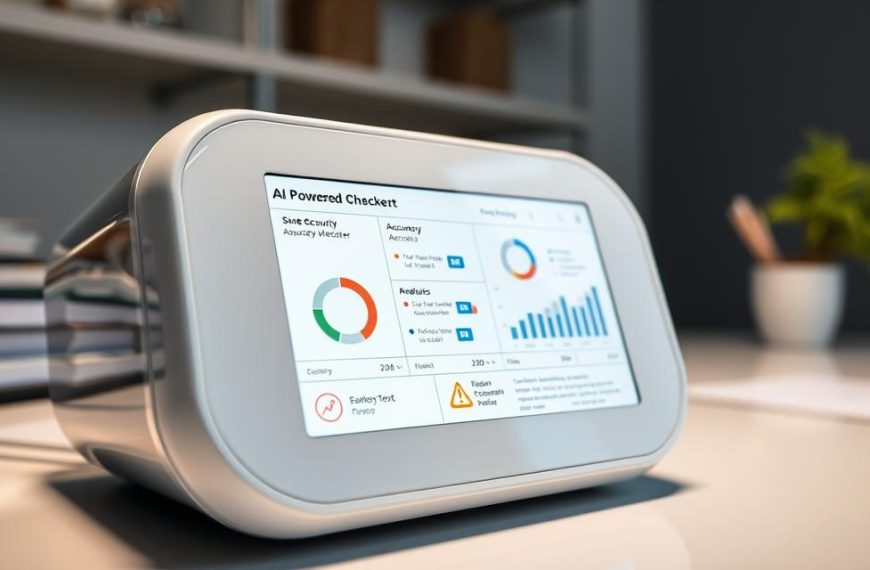The QuillBot AI Detector, launched in July 2024, is a sophisticated tool designed to classify content as AI-generated, human-written, or a hybrid of both. With an impressive accuracy rate of 80%, it has become a valuable resource for educators and content creators alike.
However, the detector faces challenges when dealing with mixed AI-human text and short inputs under 80 words. This raises questions about its effectiveness in detecting paraphrased content. Our analysis will examine the detector’s ability to identify various types of writing, including fully AI-generated content and hybrid material.
By assessing the technical mechanisms behind the detector’s algorithms, we aim to provide insights into its detection capabilities and compare it to other leading detectors in the market.
Understanding the Quillbot AI Checker
Quillbot’s AI detection technology has revolutionised the way we identify AI-generated text. The Quillbot AI Checker is a sophisticated analysis tool that distinguishes between human-written and AI-generated content through advanced pattern recognition.
What is Quillbot AI Detector?
The Quillbot AI Detector is a cutting-edge tool that examines various textual elements, including sentence structure, word choice patterns, and linguistic consistency, to differentiate AI writing from human composition. For more information on Quillbot AI, visit https://digitalsoftwarelabs.com/ai-reviews/quillbot-ai/.
How Does the AI Detection Technology Work?
The Quillbot AI Detector relies on advanced pattern recognition to spot typical markers of AI-generated content, such as repetitive phrasing, overly formal language, and consistent sentence structures. The tool analyses input text against an extensive database of AI writing patterns and models, producing a percentage score that indicates the likelihood of AI involvement.
The detector’s key features include:
- Examining sentence structure, word choice patterns, and linguistic consistency to differentiate AI writing from human composition.
- Utilising an extensive database of AI writing samples to establish baseline patterns for comparison.
- Producing a percentage-based likelihood score indicating whether content was machine-generated.
- Requiring a minimum of 80 words to deliver accurate predictions.
Testing Methodology: How We Evaluated Quillbot’s AI Detection
To thoroughly assess Quillbot’s AI detection capabilities, we employed a rigorous testing methodology that involved a diverse range of content samples.
Our testing framework was designed to evaluate Quillbot’s performance across multiple scenarios, ensuring a comprehensive understanding of its strengths and weaknesses.
Test Parameters and Content Types
The test corpus included a variety of content types, such as human-written content, AI-generated text from various models (including GPT-3.5 and GPT-4), and hybrid content combining both sources.
We specifically focused on paraphrased content, where AI-generated text had been modified to potentially evade detection systems. The test parameters included varying text lengths (from 80 words to 2,500+ words), different subject matters (technical, creative, academic), and content in multiple formats (blog posts, essays, product descriptions).
Evaluation Criteria for Detection Accuracy
Our assessment criteria measured not only raw accuracy rates but also false positive frequency, consistency across content types, and performance with deliberately challenging samples.
We established clear benchmarks for what constitutes successful detection, including the tool’s ability to correctly identify the source of content and provide accurate confidence scores.
| Content Type | Detection Accuracy |
|---|---|
| Blog Posts | 100% |
| Case Studies | 100% |
| Promotional Emails | 100% |
| Paraphrased Content | 96% |
The results of our testing are presented in the table above, demonstrating Quillbot’s high detection accuracy across various content types.
Performance Analysis: Does Quillbot Detect Paraphrased Content?
The Quillbot AI Checker has been put to the test to determine its efficacy in detecting paraphrased content. Our analysis focuses on the detector’s performance across various content types and its ability to identify AI-generated text that has been paraphrased.
Detection Accuracy for Various Content Types
The Quillbot AI Checker demonstrated excellent detection capabilities across different content types. According to our tests, it achieved a detection accuracy of 100% for blog posts, case studies, and promotional emails. However, the detector’s performance varied significantly based on content length, with optimal performance occurring in texts between 300-1,000 words.
A detailed breakdown of the detection accuracy for various content types is presented in the following table:
| Content Type | Detection Accuracy |
|---|---|
| Blog Posts | 100% |
| Case Studies | 100% |
| Promotional Emails | 100% |
| Paraphrased Content | 96% |
| Hybrid Content | 50% |
Performance with Paraphrased AI-Generated Text
The Quillbot AI Checker’s performance with paraphrased AI-generated text was particularly noteworthy, with a detection rate of 96%. This suggests that the detector is capable of identifying AI-generated content even when it has been paraphrased or manually rewritten. However, the detector’s sensitivity can sometimes lead to false positives, with approximately 15% of entirely human-written texts being incorrectly flagged as AI-generated.
For more information on the accuracy of Quillbot AI Detector, you can refer to this article.
Overall, the Quillbot AI Checker is a reliable but not infallible detection tool, achieving an overall accuracy of approximately 80% in detecting AI-generated content. Its performance is optimal for texts within a certain word count range, and it demonstrates excellent detection capabilities for various content types.
Features and Limitations of Quillbot AI Checker
When evaluating the Quillbot AI Checker, it’s essential to consider both its capabilities and limitations. This tool has gained prominence for its advanced features, but understanding its constraints is equally important for effective utilisation.
Key Strengths and Capabilities
The Quillbot AI Checker boasts several distinctive features that set it apart from other AI detection tools. Its multi-language support is particularly noteworthy, allowing users to check content in English, Spanish, German, and French. This feature makes it a versatile tool for a diverse user base.
Multi-Language Support
Quillbot’s support for multiple languages enhances its usability across different regions and languages, making it a valuable tool for global users. This capability is crucial in today’s interconnected world where content is created in various languages.
Sentence-Level Analysis
The tool’s sentence-level analysis provides detailed insights into AI-generated content, allowing for precise identification of AI characteristics within specific text portions. This granular analysis is invaluable for users seeking to understand the nuances of AI-generated writing.
User Interface and Experience
Quillbot’s user-friendly interface ensures that even non-technical users can easily navigate the tool and obtain clear, actionable results. The intuitive design facilitates a seamless user experience, making it accessible to a broad audience.
Notable Limitations and Challenges
Despite its strengths, the Quillbot AI Checker has several limitations. One significant constraint is its minimum word count requirement of 80 words, which can limit its applicability for shorter texts. Additionally, the tool struggles with hybrid content detection, often misclassifying mixed AI and human-generated text.
Minimum Word Count Requirements
The 80-word minimum can be restrictive, particularly for users who need to check brief communications or social media content. This limitation reduces the tool’s versatility for various applications.
False Positive Rate
The Quillbot AI Checker experiences a higher-than-average false positive rate, sometimes incorrectly flagging sophisticated human writing as AI-generated. This issue can lead to unnecessary scrutiny of human-created content.
Hybrid Content Detection Issues
Detecting hybrid content remains a challenge, as the tool often struggles to accurately classify text that combines AI and human writing. This limitation highlights the need for continued improvement in AI detection technology.
Comparing Quillbot with Other AI Detection Tools
Quillbot’s AI Detector is one of many tools available for detecting AI-generated content, but how does it stack up against the competition? As the demand for accurate AI detection grows, understanding the strengths and weaknesses of various tools becomes increasingly important.
Accuracy Comparison: Quillbot vs. Competitors
Our analysis reveals that Quillbot detects AI content with an accuracy rate of 78-80%, which, while respectable, is outperformed by some competitors. For instance, Scribbr achieves an accuracy rate of 84%, while GPTZero impressively reaches 99.5%. This disparity highlights the varying levels of effectiveness among AI detection tools and detectors.
The accuracy of AI detection is crucial for both content creators and educational institutions. Quillbot’s performance, while not the highest, still offers a reliable option for those seeking to verify the originality of their content. However, for applications requiring the highest accuracy, alternatives like GPTZero may be more suitable.
Value Assessment: Pricing and Features
Quillbot’s AI Detector is priced at $99.95 per year for premium access, positioning it in the mid-range compared to other AI detection tools. GPTZero, for example, is available at $20 per month, while Originality.AI operates on a pay-per-credit model. The value proposition of Quillbot is enhanced by its integration within a broader writing platform, offering users a comprehensive ecosystem that includes paraphrasing and grammar tools.
When evaluating the overall value, it’s essential to consider the specific needs of the user. For casual users and content creators, Quillbot represents a good balance of features and cost. However, for organisations requiring enterprise-level accuracy and additional features, other platforms might be more appropriate.
Conclusion: Is Quillbot AI Checker Worth Using?
After comprehensive testing, we found that Quillbot AI Checker offers a reliable, though not definitive, solution for detecting AI-generated content. With an 80% accuracy rate, it is suitable as a supplementary verification tool rather than a primary solution for high-stakes content authentication.
The Quillbot detector performs best when used for preliminary screening of longer-form content in multiple languages, particularly blog posts and academic papers. For maximum detection accuracy, especially with paraphrased or hybrid content, alternatives like GPTZero or Scribbr are recommended.


















